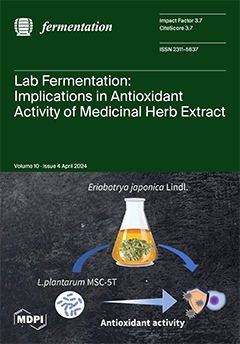Effective sulfur dioxide (SO
2) management is crucial in winemaking to minimize oxidative changes in wine flavor during storage. This study explored the impact of various SO
2 management techniques on Solaris white wine’s flavor components and sensory properties. Five treatments were
[...] Read more.
Effective sulfur dioxide (SO
2) management is crucial in winemaking to minimize oxidative changes in wine flavor during storage. This study explored the impact of various SO
2 management techniques on Solaris white wine’s flavor components and sensory properties. Five treatments were administered: ‘SO
2 in juice’ (50 mg/L SO
2 added to juice pre-fermentation), ‘Control’ (60 mg/L SO
2 added post-fermentation), ‘Low SO
2’ (50 mg/L SO
2 post-fermentation), ‘High SO
2’ (100 mg/L SO
2 post-fermentation), and ‘No SO
2’ (no SO
2 added). The ‘Control’ followed a standard procedure, in which the achieved level of free sulfite is measured and extra SO
2 added to reach the recommended level of free sulfite for the pH of the wine. Here, 50 + 10 mg/L was added. Volatile compounds were analyzed using dynamic headspace sampling coupled with gas chromatography–mass spectrometry after 0, 3, 6, and 12 months of storage. Sensory evaluation by a trained panel after 12 months revealed stronger perceptions of ‘overall impression’, ‘chemical’, ‘bitter’, ‘overripe fruit’, and ‘honey’ notes in the ‘No SO
2’ and ‘SO
2 in juice’ wines. The data underscore the significant influence of SO
2 management on the flavor stability of Solaris white wines, emphasizing the need for strategic SO
2 interventions during winemaking to enhance sensory quality over time.
Full article





